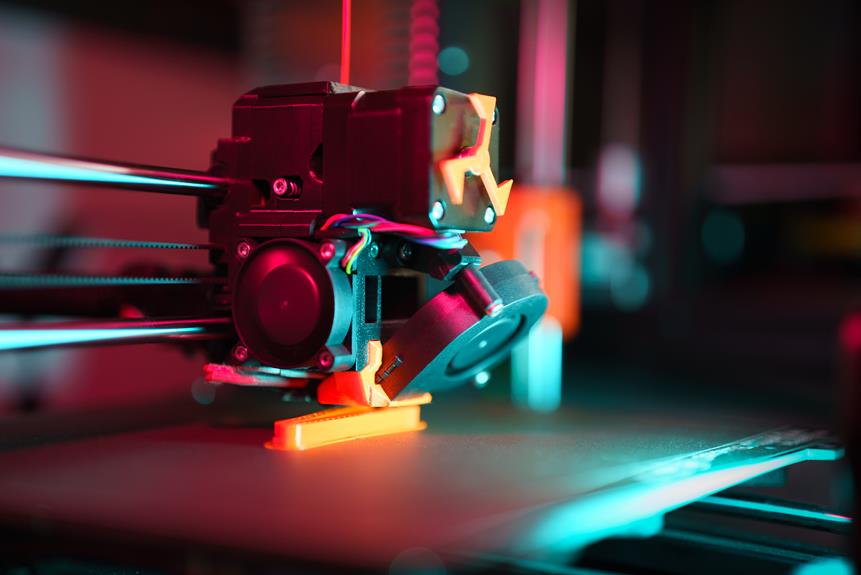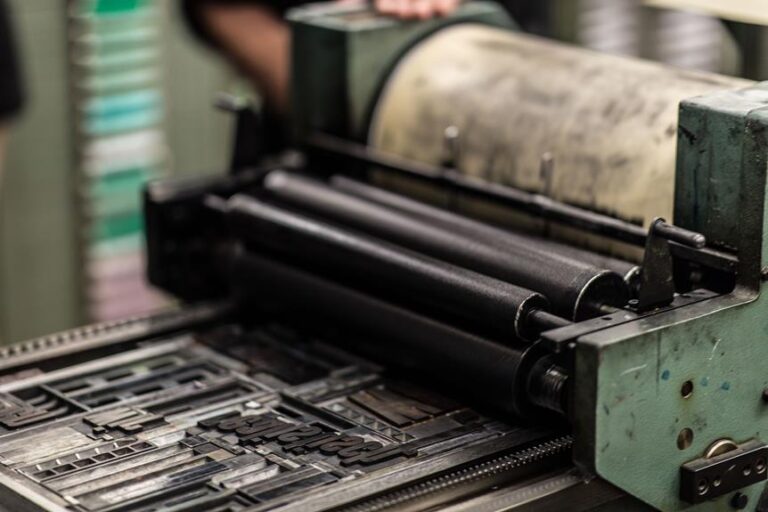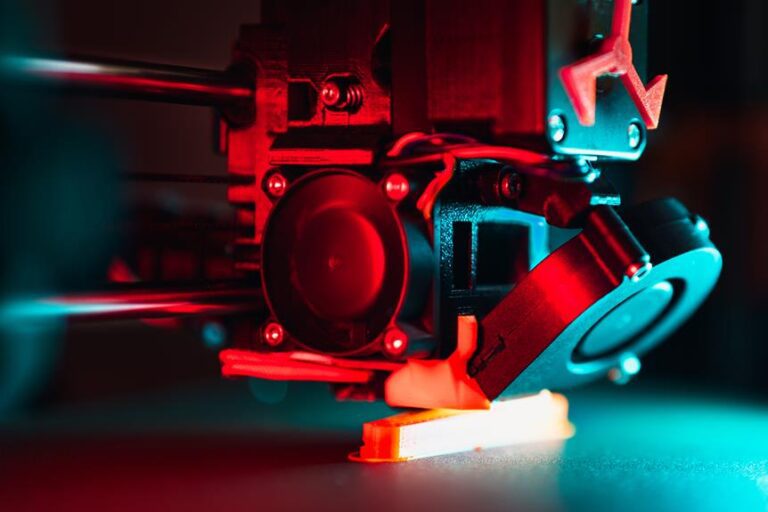Prototyping With 3D Printing: Accelerate Your Design Process
Are you tired of the slow and costly traditional prototyping methods? Look no further than the revolutionary world of 3D printing. With its ability to rapidly produce precise and intricate prototypes, this cutting-edge technology is transforming the design process.
In this article, we will explore how prototyping with 3D printing can accelerate your design process, saving you time, money, and unlocking new possibilities for innovation.
Get ready to liberate your designs and unleash your creative potential with the power of 3D printing.
Key Takeaways
- 3D printing enables rapid production of precise and intricate prototypes.
- It streamlines the design iteration process, allowing for faster production and easy modifications to prototypes.
- Rapid prototyping with 3D printing saves time and costs, helps identify design flaws earlier, and facilitates a seamless transition from concept to tangible product.
- Additive manufacturing enhances design validation by creating multiple iterations for efficient testing, reducing the risk of costly errors, and providing valuable insights into performance and usability.
The Power of 3D Printing in Prototyping
The use of 3D printing in prototyping offers a significant advantage in terms of speed and efficiency. Rapid prototyping, also known as additive manufacturing prototyping, has revolutionized the design process by allowing engineers and designers to quickly create physical prototypes of their concepts. This technology enables the production of complex geometries and intricate designs that were previously challenging or impossible to achieve using traditional manufacturing methods.
One of the key benefits of 3D printing in prototyping is the ability to validate designs before moving into mass production. By creating physical models, designers can evaluate the form, fit, and function of their products, identifying any potential flaws or areas for improvement. This iterative process allows for faster design iterations, reducing development time and costs.
Additionally, 3D printing enables the production of prototypes with high accuracy and precision. This level of detail is crucial for industries such as aerospace, automotive, and medical, where even the smallest deviation can have significant consequences. Additive manufacturing prototyping also offers the flexibility to experiment with different materials, allowing engineers to test and optimize the performance of their designs.
Streamlining Design Iteration With 3D Printing
By utilizing 3D printing technology, designers can streamline the design iteration process, allowing for faster and more efficient development of prototypes. With traditional prototyping methods, designers often face challenges such as high costs, long lead times, and limited customization options. However, 3D printing has revolutionized the prototyping landscape, offering numerous benefits that enable designers to iterate their designs more effectively.
Here are four ways in which 3D printing streamlines the design iteration process:
- Rapid Turnaround: 3D printing enables designers to quickly produce physical prototypes within hours or days, reducing the time required for each design iteration. This allows for faster validation of ideas and the ability to make necessary modifications promptly.
- Cost-Effective: Compared to traditional prototyping methods, 3D printing eliminates the need for expensive tooling and reduces material waste. This cost-effectiveness enables designers to iterate multiple design variations without breaking the bank.
- Design Freedom: With 3D printing, designers have the freedom to create complex geometries and intricate details that would be challenging or impossible with traditional manufacturing techniques. This enables them to explore innovative designs and push the boundaries of what is possible.
- Iterative Refinement: 3D printing allows for easy and quick modifications to prototypes. Designers can print multiple iterations, test them, and make adjustments based on feedback, leading to an iterative refinement process that accelerates the development of the final product.
Saving Time and Money Through Rapid Prototyping
Through the use of rapid prototyping, designers can save both time and money by quickly creating and testing multiple iterations of their designs. Rapid prototyping refers to the process of creating physical prototypes using 3D printing technology. This method allows designers to visualize their concepts and make necessary changes before moving forward with production.
One major advantage of rapid prototyping is the ability to speed up the design process. Traditionally, creating physical prototypes required significant time and resources. Designers had to wait for molds to be created or rely on manual craftsmanship. With rapid prototyping, designers can quickly convert their digital designs into physical prototypes, reducing the time it takes to go from concept to tangible product.
Furthermore, rapid prototyping helps designers identify and rectify design flaws earlier in the process. By creating multiple iterations of the design, designers can test different variations and make improvements based on feedback. This iterative approach allows for a more refined final design, minimizing the risk of costly errors during production.
Another key benefit of rapid prototyping is cost savings. By identifying and resolving design issues early on, designers can avoid expensive modifications later in the production process. Additionally, 3D printing eliminates the need for complex manufacturing tools and molds, reducing upfront costs.
Enhancing Design Validation With Additive Manufacturing
Additive manufacturing enables designers to enhance design validation through the creation of physical prototypes. This technology has revolutionized the design process by allowing designers to quickly and accurately evaluate their designs before moving into production.
Here are four ways in which additive manufacturing enhances design validation:
- Faster Iterations: With 3D printing, designers can rapidly produce multiple iterations of a design, allowing for quick and efficient testing and refinement. This enables designers to identify and address potential issues early in the design process.
- Realistic Testing: Additive manufacturing allows designers to create prototypes that closely resemble the final product, both in terms of form and function. This enables realistic testing of the design, providing valuable insights into its performance and usability.
- Cost Savings: By identifying and resolving design issues early on, additive manufacturing reduces the risk of costly errors during production. This leads to significant cost savings by minimizing the need for design revisions and production delays.
- Design Optimization: Additive manufacturing enables designers to explore complex geometries and create intricate designs that were previously impossible with traditional manufacturing methods. This opens up new possibilities for design optimization and innovation.
In the next section, we will explore how 3D printed prototypes expand the possibilities for designers, allowing them to push the boundaries of creativity and innovation.
Expanding Possibilities With 3D Printed Prototypes
Designers can now explore a wide range of innovative solutions and push the boundaries of their creativity with the use of 3D printed prototypes. This technology revolutionizes the design process by allowing designers to rapidly create physical models of their ideas, providing a tangible representation of their concepts. With 3D printed prototypes, designers can easily test and refine their designs, accelerating the development cycle and reducing the time and cost associated with traditional prototyping methods.
One of the key advantages of 3D printed prototypes is the ability to create complex geometries that would be impossible to achieve with traditional manufacturing techniques. This opens up new possibilities for designers to create intricate and customized designs that were previously unattainable. By leveraging the capabilities of 3D printing, designers can explore unconventional shapes, intricate patterns, and unique textures, giving their designs a distinctive and eye-catching appeal.
Furthermore, 3D printed prototypes offer the freedom to iterate quickly and make design modifications on the fly. Designers can easily make adjustments to their prototypes, allowing them to evaluate multiple design options and select the most optimal solution. This flexibility in the design process empowers designers to experiment and take risks, leading to more innovative and groundbreaking designs.
In addition, 3D printed prototypes enable designers to visualize their designs in a realistic manner. By creating physical models, designers can better understand the ergonomics, functionality, and aesthetics of their designs. This hands-on approach allows designers to identify any potential issues or areas for improvement, leading to more refined and user-friendly products.
Accelerating Innovation Through 3D Printing
To accelerate innovation in product development, companies can leverage the power of 3D printing in combination with other advanced technologies. This combination allows for faster design iterations, reduced costs, and improved product quality.
Here are four ways in which 3D printing can accelerate innovation in the product development process:
- Rapid Prototyping: 3D printing enables the quick and cost-effective production of prototypes, allowing designers to test and iterate on their ideas more efficiently. This speeds up the design process and allows for faster innovation.
- Customization: With 3D printing, companies can easily create customized products to meet individual customer needs. This level of customization can lead to greater customer satisfaction and can drive innovation by offering unique solutions to specific problems.
- Complex Geometries: 3D printing technology enables the production of complex geometries that would be difficult or impossible to achieve using traditional manufacturing methods. This opens up new possibilities for innovative product designs.
- Collaboration: 3D printing facilitates collaboration between different teams and departments within a company. It allows for the sharing of digital design files and the rapid production of physical prototypes, enabling faster feedback and iteration.
Overcoming Design Challenges With Additive Manufacturing
When utilizing additive manufacturing for prototyping, designers often face various challenges that need to be overcome.
One of these challenges is the optimization of the design, which involves techniques such as topology optimization and lattice structures to improve the performance and functionality of the final product.
Additionally, material selection is crucial in additive manufacturing, as different materials have varying mechanical properties and compatibility with the printing process.
Design Optimization Techniques
The utilization of advanced design optimization techniques is crucial for overcoming the design challenges associated with additive manufacturing. By employing these techniques, designers can optimize their designs to take full advantage of the capabilities of 3D printing technology.
Here are four key design optimization techniques to consider:
- Topology optimization: This technique involves optimizing the shape and structure of a design to achieve the desired performance while minimizing material usage.
- Lattice structures: By incorporating lattice structures into designs, it is possible to reduce weight and material consumption while maintaining structural integrity.
- Support optimization: Additive manufacturing often requires support structures during printing. Optimizing these supports can minimize material waste and facilitate easier post-processing.
- Part consolidation: With additive manufacturing, it is possible to consolidate multiple parts into a single complex design, reducing assembly time and simplifying logistics.
Material Selection Considerations
With careful consideration of material properties and compatibility, as well as the specific requirements of the design, designers can effectively overcome the challenges associated with additive manufacturing and make informed decisions for material selection.
Material selection is a critical aspect of the 3D printing process, as it directly impacts the performance and functionality of the final product. When choosing materials for additive manufacturing, designers must consider factors such as mechanical properties, thermal characteristics, chemical resistance, and cost.
Each material has its own set of advantages and limitations, and these must be evaluated against the requirements of the design. For example, if the design requires high strength and durability, materials such as nylon or carbon fiber-reinforced plastics may be suitable. On the other hand, if the design requires heat resistance, materials like polycarbonate or PEEK can be considered.
Reducing Time-To-Market Constraints
Additive manufacturing provides designers with the opportunity to overcome design challenges and reduce time-to-market constraints through its innovative and efficient prototyping capabilities. By utilizing 3D printing technology, designers can accelerate the design process and bring their products to market faster.
Here are four ways in which additive manufacturing can help reduce time-to-market constraints:
- Rapid prototyping: 3D printing allows for quick and cost-effective production of prototypes, enabling designers to iterate and refine their designs at a much faster pace.
- Design optimization: With the ability to create complex geometries and custom designs, additive manufacturing enables designers to optimize their product designs for better performance and functionality.
- On-demand production: By leveraging additive manufacturing, designers can produce small batch or custom products on-demand, eliminating the need for traditional manufacturing processes and reducing lead times.
- Faster design iterations: With the ability to quickly produce and test multiple design iterations, designers can identify and address potential issues early in the product development process, reducing overall development time.
Unlocking Design Potential With 3D Printed Prototypes
By utilizing 3D printed prototypes, designers can explore and enhance their creations through a hands-on and iterative process, fostering innovation and pushing the boundaries of design. With traditional prototyping methods, designers often face limitations in terms of cost, time, and complexity. However, 3D printing enables them to overcome these constraints and unlock their design potential.
One of the key advantages of 3D printed prototypes is the freedom it offers in terms of design complexity. Traditional manufacturing processes often have limitations in producing intricate and complex geometries. With 3D printing, designers can create highly detailed and intricate designs that were previously impossible to achieve. This allows for the exploration of new aesthetic possibilities and the creation of unique and visually stunning designs.
Furthermore, 3D printed prototypes allow for rapid iteration and refinement of designs. Designers can quickly create multiple iterations of their prototypes, test them, and make necessary improvements. This iterative process helps to identify design flaws early on, resulting in more refined and functional final products.
Maximizing Efficiency in the Design Process With 3D Printing
To streamline the design process and optimize productivity, designers can leverage the benefits of 3D printing technology through the implementation of efficient workflows and utilization of advanced design software. By incorporating these strategies, designers can maximize efficiency in the design process, saving time and resources while producing high-quality prototypes.
Here are four ways to maximize efficiency in the design process with 3D printing:
- Rapid Iteration: 3D printing allows designers to quickly create and test multiple design iterations, enabling them to refine their ideas and make necessary modifications more efficiently than traditional manufacturing methods.
- Design Validation: With 3D printing, designers can create physical prototypes to validate their designs before committing to costly tooling or production. This eliminates the need for time-consuming and expensive manual machining or outsourcing of prototypes.
- Design Optimization: By using advanced design software, designers can optimize their models for 3D printing, taking advantage of features such as lattice structures, lightweight designs, and complex geometries. This optimization can lead to improved performance and reduced material usage.
- Collaboration and Communication: 3D printing facilitates collaboration between designers, engineers, and stakeholders by providing a tangible representation of the design. This allows for better communication, faster decision-making, and a more iterative design process.
Frequently Asked Questions
How Does 3D Printing Technology Work?
3D printing technology works by using additive manufacturing to create three-dimensional objects layer by layer. It involves the use of a digital model that is sliced into thin cross-sections, which are then printed using various materials such as plastic, metal, or resin.
What Are Some Common Materials Used in 3D Printing?
Common materials used in 3D printing include thermoplastics, such as ABS and PLA, which offer durability and flexibility. Additionally, metals like titanium and aluminum are often used for their strength and heat resistance. Other materials include ceramics, resins, and composites.
Can 3D Printed Prototypes Be Used for Functional Testing?
Yes, 3D printed prototypes can be used for functional testing. They allow designers to iterate quickly, test various design iterations, and identify flaws or improvements before committing to final production, thus accelerating the design process.
What Are the Limitations of 3D Printing in Prototyping?
The limitations of 3D printing in prototyping include limited material options, slower production times compared to traditional methods, and the need for post-processing to achieve desired surface finishes.
How Can 3D Printed Prototypes Be Integrated Into the Production Process?
3D printed prototypes can be integrated into the production process by using them for functional testing, evaluating design changes, and obtaining feedback from stakeholders. This allows for faster iteration and optimization of the final product.
Conclusion
In conclusion, 3D printing is a powerful tool that can significantly accelerate the design process. By streamlining design iteration, saving time and money, enhancing design validation, and expanding possibilities, 3D printed prototypes enable designers to accelerate innovation and overcome design challenges.
This additive manufacturing technology unlocks the full potential of design and maximizes efficiency in the design process. Like a precision instrument, 3D printing allows designers to finely tune their creations, bringing them closer to perfection.









